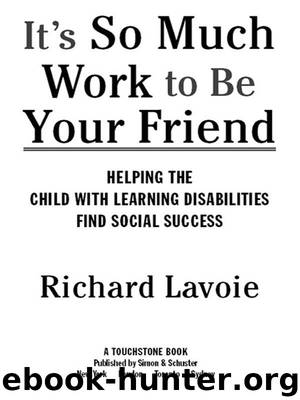It's So Much Work to Be Your Friend by Richard Lavoie

Author:Richard Lavoie
Language: eng
Format: epub
Publisher: Simon & Schuster
Published: 2005-07-15T00:00:00+00:00
Clearly, a child who does not have the benefit of positive sibling relationships is at a marked disadvantage. The sibling relationship is the only truly lifelong relationship that we have. Our relationships with our parents will last forty to fifty years, but our link to our siblings is likely to last sixty to eighty years. This relationship takes on even greater significance in the opening of the twenty-first century because of some recent cultural and sociological changes. As family size decreases and human life span increases, our sibling relationships become even more significant and meaningful in our lives. Today’s children are being raised in families that are mobile and stressed; further, both parents are often employed full time. Those factors increase the child’s dependency upon his or her siblings for support, care, and friendship.
The relationship between siblings develops and changes throughout the life span. As young children, we are greatly dependent upon our siblings for companionship. Throughout the elementary school years, this dependency decreases as we make contacts with classmates and teammates in our communities. At adolescence, the sibling relationship can assume a degree of ambivalence or even hostility. As we become adults, the relationship becomes more solid and mature as we recognize that our common heritage and shared experiences are far more significant than the petty differences and disagreements that had previously been the flashpoints for conflict. At old age, as children move away and spouses die, siblings often become significant sources of support and comfort to one another.
Rivalry, jealousy, and conflict among siblings is normal and natural. Parents should be cautious not to overreact to the typical rough-and-tumble relationships between brothers and sisters. The bond between most siblings is strong enough to overcome the ritualistic teasing and hassling that often characterize these relationships in the preteen and adolescent years. Again, reflect upon your own sibling relationships and you will realize that most of the rivalries, slights, and skirmishes that you shared with brothers and sisters during childhood are now long forgotten and forgiven.
The reasons for sibling rivalry and skirmishes are quite understandable. A child’s relationship with his parents is characterized by the fact that both the child and the parent are fully aware that the latter has more experience, knowledge, and control than the former. However, in a sibling pairing, there exists an ongoing battle for superiority, power, and control. Contributing to this conflict is each child’s persistent belief that his sibling is receiving a disproportionate amount of parental time, energy, resources, attention, and love. This makes fighting between siblings far more common than conflict between classmates or teammates. It has been said that you can select your friends, but you can’t choose your family. This fact, coupled with the intense exposure that siblings have to one another, creates a hotbed for hostility and conflict.
The complexity of these relationships is greatly enhanced when one of the siblings has significant learning and language problems. The pleasures, pressures, and intensity of the sibling relationship are magnified. Research in this area
Download
This site does not store any files on its server. We only index and link to content provided by other sites. Please contact the content providers to delete copyright contents if any and email us, we'll remove relevant links or contents immediately.
| Behavioral Disorders | Communicative Disorders |
| Gifted Students | Inclusive Education |
| Learning Disabled | Mentally Disabled |
| Physically Disabled |
The Art of Coaching Workbook by Elena Aguilar(48393)
Trainspotting by Irvine Welsh(20102)
Twilight of the Idols With the Antichrist and Ecce Homo by Friedrich Nietzsche(17730)
Fangirl by Rainbow Rowell(7858)
Periodization Training for Sports by Tudor Bompa(7350)
Change Your Questions, Change Your Life by Marilee Adams(6677)
This Is How You Lose Her by Junot Diaz(5813)
Grit by Angela Duckworth(4756)
Red Sparrow by Jason Matthews(4700)
Asking the Right Questions: A Guide to Critical Thinking by M. Neil Browne & Stuart M. Keeley(4615)
Paper Towns by Green John(4186)
Room 212 by Kate Stewart(4130)
Ken Follett - World without end by Ken Follett(3987)
The Sports Rules Book by Human Kinetics(3607)
Housekeeping by Marilynne Robinson(3433)
The Motorcycle Diaries by Ernesto Che Guevara(3355)
Introduction to Kinesiology by Shirl J. Hoffman(3313)
Exercise Technique Manual for Resistance Training by National Strength & Conditioning Association(3312)
Double Down (Diary of a Wimpy Kid Book 11) by Jeff Kinney(3294)
